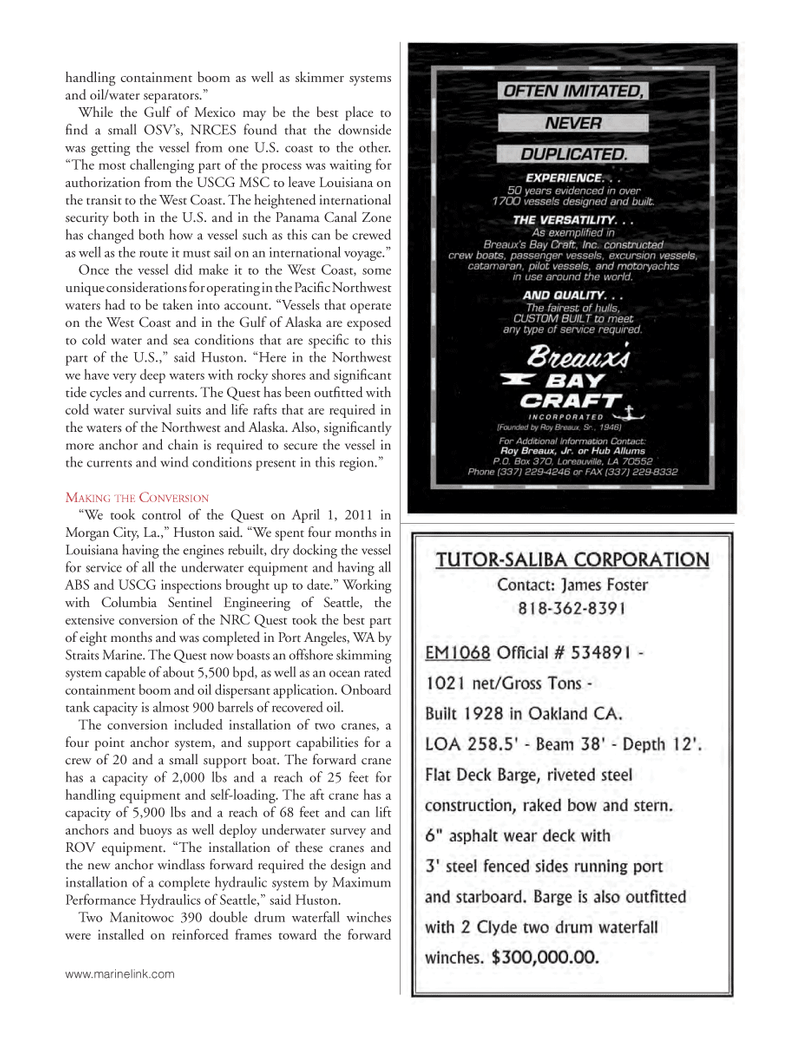
Page 33: of Marine News Magazine (September 2012)
Environment: Stewardship & Compliance
Read this page in Pdf, Flash or Html5 edition of September 2012 Marine News Magazine
handling containment boom as well as skimmer systems and oil/water separators.?While the Gulf of Mexico may be the best place to nd a small OSV?s, NRCES found that the downside was getting the vessel from one U.S. coast to the other. ?The most challenging part of the process was waiting for authorization from the USCG MSC to leave Louisiana on the transit to the West Coast. The heightened international security both in the U.S. and in the Panama Canal Zone has changed both how a vessel such as this can be crewed as well as the route it must sail on an international voyage.? Once the vessel did make it to the West Coast, some unique considerations for operating in the Paci c Northwest waters had to be taken into account. ?Vessels that operate on the West Coast and in the Gulf of Alaska are exposed to cold water and sea conditions that are speci c to this part of the U.S.,? said Huston. ?Here in the Northwest we have very deep waters with rocky shores and signi cant tide cycles and currents. The Quest has been out tted with cold water survival suits and life rafts that are required in the waters of the Northwest and Alaska. Also, signi cantly more anchor and chain is required to secure the vessel in the currents and wind conditions present in this region.? MAKING THE CONVERSION?We took control of the Quest on April 1, 2011 in Morgan City, La.,? Huston said. ?We spent four months in Louisiana having the engines rebuilt, dry docking the vessel for service of all the underwater equipment and having all ABS and USCG inspections brought up to date.? Working with Columbia Sentinel Engineering of Seattle, the extensive conversion of the NRC Quest took the best part of eight months and was completed in Port Angeles, WA by Straits Marine. The Quest now boasts an offshore skimming system capable of about 5,500 bpd, as well as an ocean rated containment boom and oil dispersant application. Onboard tank capacity is almost 900 barrels of recovered oil. The conversion included installation of two cranes, a four point anchor system, and support capabilities for a crew of 20 and a small support boat. The forward crane has a capacity of 2,000 lbs and a reach of 25 feet for handling equipment and self-loading. The aft crane has a capacity of 5,900 lbs and a reach of 68 feet and can lift anchors and buoys as well deploy underwater survey and ROV equipment. ?The installation of these cranes and the new anchor windlass forward required the design and installation of a complete hydraulic system by Maximum Performance Hydraulics of Seattle,? said Huston. Two Manitowoc 390 double drum waterfall winches were installed on reinforced frames toward the forward www.marinelink.com MNSept2012 Layout 32-42.indd 33MNSept2012 Layout 32-42.indd 338/30/2012 3:33:50 PM8/30/2012 3:33:50 PM

 32
32

 34
34
